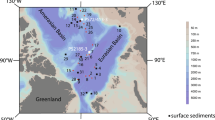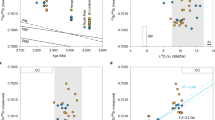Abstract
THE existence of temporal changes in the chemical composition of the oceans, which could provide constraints on the potential variability of the ocean–atmosphere; system, remains an open question. Assessments of the chemistry of ancient oceans have relied largely on analysis of marine precipitates, generally carbonate and evaporite minerals1. These studies suggest that, whereas marine salinity has remained relatively stable over Phanerozoic time1, magnesium, calcium and sulphate concentrations of ancient oceans and CO2 partial pressure of ancient atmospheres may have changed2–4. The ratios of isotopes of carbon, oxygen, sulphur and strontium also appear to have varied3,5,6. Here we present analyses of primary, one-phase fluid inclusions in Cambrian and Ordovician marine cements, which appear to represent aliquots of early Palaeozoic oceans. The cements have trace element, stable isotope and strontium isotope contents that are consistent with their having been precipitated in a Cambrian–Ordovician marine environment, and the fluids have marine salinities. As these (apparently primary) cements are low-magnesium calcite, unlike the predominantly high-magnesium calcite and aragonite of today's carbonate precipitates, the chemistry of the Cambrian ocean–atmosphere system seems to have been different from that of today.
This is a preview of subscription content, access via your institution
Access options
Subscribe to this journal
Receive 51 print issues and online access
$199.00 per year
only $3.90 per issue
Buy this article
- Purchase on Springer Link
- Instant access to full article PDF
Prices may be subject to local taxes which are calculated during checkout
Similar content being viewed by others
References
Holland, H. D. The Chemical Evolution of the Atmosphere and Oceans (Princeton Univ. Press, 1984).
Wilkinson, B. H. & Algeo, T. J. Am. J. Sci. 239, 1158–1194 (1989)
Claypool, G. E., Holser, W. T., Kaplan, I. R., Sakai, H. & Zak, I. Chem. Geol. 28, 199–260 (1980).
Berner, R. A. Science 249, 1382–1386 (1990).
Lohmann, K. C. & Walker, J. C. G. Geophys. Res. Lett. 16, 319–322 (1989).
Burke, W. H. et al. Geology 10, 516–519 (1982).
Sandberg, P. A. Nature 305, 19–22 (1983).
Mackenzie, F. T. & Pigott, J. D. J geol. Soc. Lond. 138, 183–196 (1981).
Wilkinson, B. H., Owen, R. M. & Carroll, A. R. J. sedim. Petrol. 55, 171–183 (1985).
Palmer, T. J., Hudson, J. D. & Wilson, M. A. Nature 335, 809–810 (1988).
Bathurst, R. G. C. Carbonate Sediments and their Diagenesis (Elsevier, Amsterdam, 1975).
Wilkinson, B. H. J. geol. Educ. 30, 189–203 (1982).
Sandberg, P. A. in The Carbon Cycle and Atmospheric CO2 Natural Variations Archean to Present (eds Sundquist, E. T. & Broecker, W. S.) 585–594 (Am. Geophys. Un., Washington DC, 1985).
Roedder, E. Fluid Inclusions (Min. Soc. of America, Washington DC, 1984).
Goldstein, R. H. J. sedim. Petrol. 60, 282–292 (1990).
Lyman, J. & Fleming, R. H. J. mar. Res. 3, 134–146 (1940).
Purser, B. H. & Seiboid, E. in The Perslon Gulf: Holocene Carbonate Sedimentation and Diagenesis in a Shallow Epicontinental Sea (ed. Purser, B. H.) 1–9 (Springer, Berlin, 1973).
Carpenter, S. J. et al. Geochim. cosmochim. Acta 55, 1991–2010 (1991).
Ripperdan, R. L., Margaritz, M., Nicoll, R. S. & Shergold, J. H. Geology 20, 1039–1042 (1992).
Gonzalez, L. A. & Lohmann, K. C. Geology 13, 811–814 (1985).
Major, R. P. & Wilber, R. J. Bull. geol. Soc. Am. 103, 461–471 (1991).
Carpenter, S. J. & Lohmann, K. C. Geochim. cosmochim. Acta 56, 1837–1849 (1992).
Lohmann, K. C. & Meyers, W. J. J. sedim. Petrol. 48, 475–488 (1977).
Schlager, W. & James, N. P. Sedimentology 25, 675–702 (1978).
Weiss, C. P. & Wilkinson, B. H. J. sedim. Petrol 58, 468–478 (1988).
Brand, U. & Veizer, J. J. sedim. Petrol. 50, 1219–1236 (1980).
Wilkinson, B. H. Geology 7, 524–527 (1979).
Author information
Authors and Affiliations
Rights and permissions
About this article
Cite this article
Johnson, W., Goldstein, R. Cambrian sea water preserved as inclusions in marine low-magnesium calcite cement. Nature 362, 335–337 (1993). https://doi.org/10.1038/362335a0
Received:
Accepted:
Published:
Issue Date:
DOI: https://doi.org/10.1038/362335a0
This article is cited by
-
Geological age of the Jeongseon Formation, Joseon Supergroup (lower Paleozoic): a perspective from carbon isotope stratigraphy
Geosciences Journal (2007)
-
Ancient sea water
Nature (1993)
Comments
By submitting a comment you agree to abide by our Terms and Community Guidelines. If you find something abusive or that does not comply with our terms or guidelines please flag it as inappropriate.



